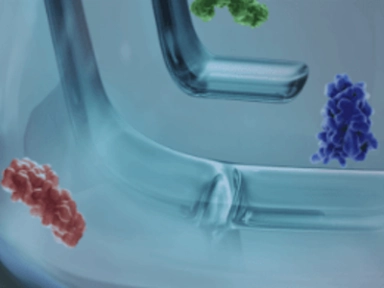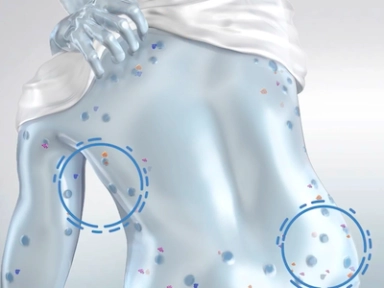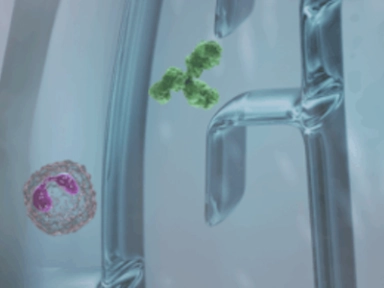{
event: "article_read",
name: `Prurigo Nodularis is a distinct, Chronic, Neural and Immune- Mediated skin disease characterized by intense itch and Nodular Lesions¹`,
author: ``,
tags: `Prurigo Nodularis`,
publication_date: ``,
interaction_type: "content"
}
Prurigo Nodularis is a distinct, Chronic, Neural and Immune- Mediated skin disease characterized by intense itch and Nodular Lesions¹
PN is characterized by the following:
-
Chronic pruritus1,2
- Pruritus lasting ≥6 weeks is required for a diagnosis2
- Most patients (>80%) have pruritus for >6 months and over half of patients
experience pruritus for >2 years3 - PN is regarded as having the highest itch intensity among the many diverse types
of chronic pruritus4-6 - The most burdensome symptom as rated by patients with PN is itch3,a
-
Presence of multiple, firm, pruriginous lesions1,2,b
- Visibility of skin lesions and bleeding of skin lesions are the second and third most burdensome symptoms as rated by patients3,b
- History and/or evidence of repeated scratching, picking, or rubbing (eg, excoriations and scars)2
PN negatively affects many aspects of patients’ quality of life, including7,8:
-
Sleep9,c
- Pruritus is often worse in the evening or at night
- Over 60% of patients with PN report that itching disturbs their sleep “to a great extent”
-
Mental health7,10,11
- Patients with PN are more likely to have depression or anxiety compared with healthy individuals
-
Activities of daily living12,d
- Over 50% of patients report that their everyday life is affected by PN
-
Social interactions12,d
- 38% of patients report that itch affects their interactions with others
PN may be associated with the following comorbidities2,8:
- Chronic conditions eg, Chronic kidney disease
- Dermatological conditions eg, Atopic dermatitis
- Infections eg, HIV
- Psychiatric conditions eg, Depression
PN can arise as a distinct disease in the absence of any of the comorbidities above
The debilitating signs and symptoms of PN result in significantly reduced quality of life, including negatively impacting sleep, mental health, activities of daily living, and social interactions. In addition, PN may also be associated with a range of comorbidities8
- Elmariah S, Kim B, Berger T, et al. Practical approaches for diagnosis and management of prurigo nodularis: United States expert panel consensus. J Am Acad Dermatol. 2021;84(3):747-760.
- Ständer HF, Elmariah S, Zeidler C, Spellman M, Ständer S. Diagnostic and treatment algorithm for chronic nodular prurigo. J Am Acad Dermatol. 2020;82(2):460-468.
- Pereira MP, Basta S, Moore J, Ständer S. Prurigo nodularis: a physician survey to evaluate current perceptions of its classification, clinical experience and unmet need. J Eur Acad Dermatol Venereol. 2018;32(12):2224-2229.
- Iking A, Grundmann S, Chatzigeorgakidis E, Phan NQ, Klein D, Ständer S. Prurigo as a symptom of atopic and non-atopic diseases: aetiological survey in a consecutive cohort of 108 patients. J Eur Acad Dermatol Venereol. 2013;27(5):550-557.
- Mollanazar NK, Elgash M, Weaver L, Valdes-Rodriguez R, Hsu S. Reduced itch associated with dupilumab treatment in 4 patients with prurigo nodularis. JAMA Dermatol. 2019;155(1):121-122.
- Zeidler C, Yosipovitch G, Ständer S. Prurigo nodularis and its management. Dermatol Clin. 2018;36(3):189-197.
- Williams KA, Huang AH, Belzberg M, Kwatra SG. Prurigo nodularis: pathogenesis and management. J Am Acad Dermatol. 2020;83(6):1567-1575.
- Huang AH, Canner JK, Khanna R, Kang S, Kwatra SG. Real-world prevalence of prurigo nodularis and burden of associated diseases. J Invest Dermatol. 2020;140(2):480-483.e4.
- Gwillim EC, Nattkemper L, Yosipovitch G. Impact of itch on sleep disturbance in patients with prurigo nodularis. Acta Derm Venereol. 2021;101(3):adv00424.
- Pereira MP, Steinke S, Zeidler C, et al. European academy of dermatology and venereology European prurigo project: expert consensus on the definition, classification and terminology of chronic prurigo. J Eur Acad Dermatol Venereol. 2018;32(7):1059-1065.
- Jørgensen KM, Egeberg A, Gislason GH, Skov L, Thyssen JP. Anxiety, depression and suicide in patients with prurigo nodularis. J Eur Acad Dermatol Venereol. 2017;31(2):e106-e107.
- Pereira MP, Zeidler C, Wallengren J, et al. Chronic nodular prurigo: a European cross-sectional study of patient perspectives on therapeutic goals and satisfaction. Acta Derm Venereol. 2021;101(2):1-7.
Related articles
MAT-BH-2200541/V1/June 2022




